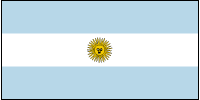| Country (long form) |
Argentine Republic |
| Capital |
Buenos Aires |
| Total Area |
1,068,302.20 sq mi
2,766,890.00 sq km
(slightly less than three-tenths the size of the US) |
| Population |
37,384,816 (July 2001 est.) |
| Estimated Population in 2050 |
50,119,441 |
| Languages |
Spanish (official), English, Italian, German, French |
| Literacy |
96.2% total, 96.2% male, 96.2% female (1995 est.) |
| Religions |
nominally Roman Catholic 92% (less than 20% practicing), Protestant 2%, Jewish 2%, other 4% |
| Life Expectancy |
71.88 male, 78.82 female (2001 est.) |
| Government Type |
republic |
| Currency |
1 peso = 100 centavos |
| GDP (per capita) |
$12,900 (2000 est.) |
| Industry |
food processing, motor vehicles, consumer durables, textiles, chemicals and petrochemicals, printing, metallurgy, steel |
| Agriculture |
sunflower seeds, lemons, soybeans, grapes, corn, tobacco, peanuts, tea, wheat; livestock
|
| Arable Land |
9% |
| Natural Resources |
fertile plains of the pampas, lead, zinc, tin, copper, iron ore, manganese, petroleum, uranium |
|


|